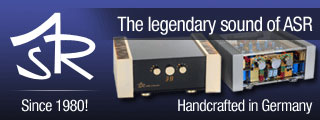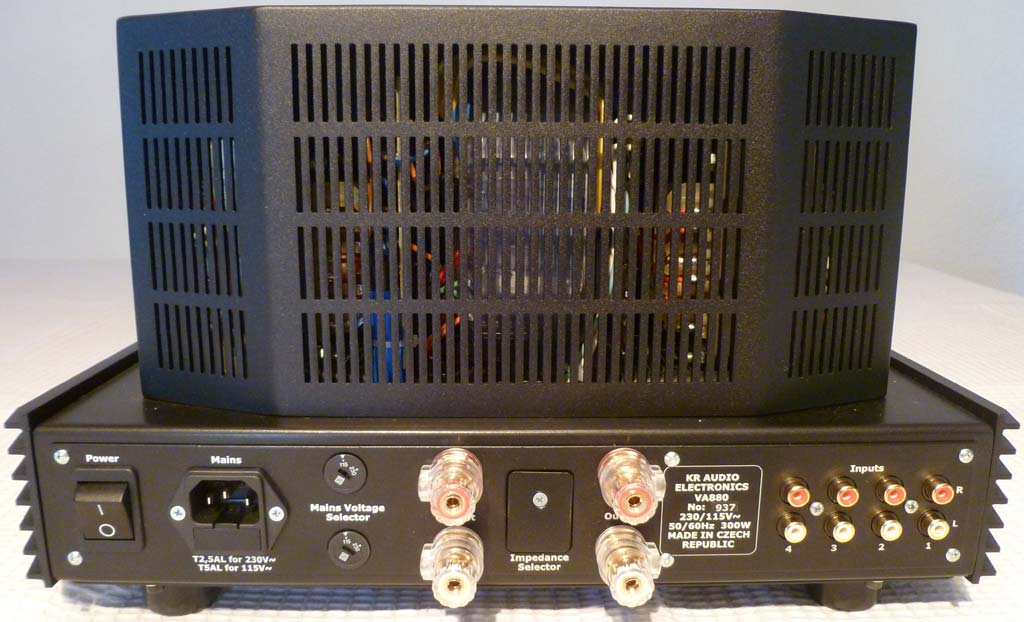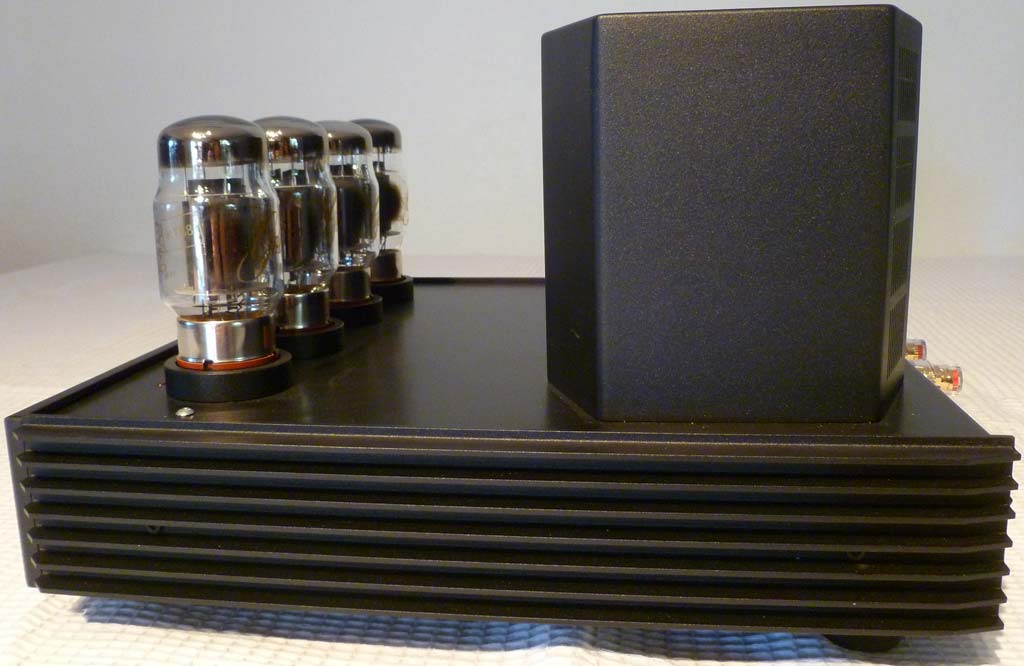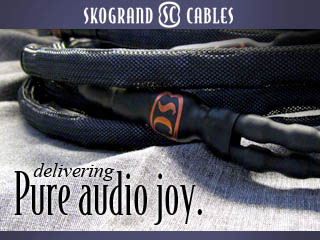Controlled, but not restrained
The initial impression of the KR VA880’s sound was one of control. Up to the point of power compression, I heard none of the softness I associate with a stereotypical tube integrated amp. It was fast and clean, with good damping. While testing the difficult Audio Technica AT150mlx cartridge, one of the fastest cartridges I’ve used, the amp never slowed things down, and didn’t seem at all challenged by the most difficult recordings, analog or digital. I’m guessing a moderate amount of feedback is used to increase damping, but not so much as to create more irritating forms of distortion.
Detail retrieval is very good. Lyrics and musical lines are easy to pick out. Compared to most all-tube integrated amps I’ve used, it has a slight edge. On loud, sustained musical passages, the even-order distortion would creep up a little and add a bit of haze, but nothing like the vast, vast majority of single ended amps, which get noticeably fuzzy when loud.
The quietness of the amp is very impressive. I detected no noise, whether radiated from the speakers, or from the power transformer. Even with the volume turned all the way up, the noise was inaudible at the listening position. There was just a wee bit of hash, but it’s way, way down from the signal. It’s as quiet as any tube product I can remember.
The “Technicolor” qualities of a typical tube product weren’t apparent in the KR: no golden hues or extra warmth; no softened focus; no brashness on loud passages; and no artificial air. On the other hand, it wasn’t murky. Unlike transistors, which often have an artificial darkness and missing detail, and the typical tube product which sometimes possesses frequency response issues along with way too much distortion, it walks a fine line. Truthfully, it seems to balance the sound of a good tube and a good transistor amp.
As I was alluding to, frequency response is admirably flat for an amp of 50 watts per channel. At full power, the bass starts to roll off in the 25-30 Hz range, but the highs seem to go on to inaudibility without deviation. Compared to the biggest and baddest tube amps, with the most overbuilt output transformers, the low bass of the VA-880 lags behind in comparison to the mids and highs. It has great speed and detail, and great dynamics as well, but the bass sustain is a little soft and suggests that the output transformers are starting to saturate before the amp clips or compresses. Unless your speakers play relatively flat to 30 HZ, with useable extension to 15Hz, you won’t hear it. If it errs one way or the other, the amp has very slight silvery quality, one I associate more with passive parts selection, rather than circuit or active devices.
My pet peeve with solid state gear has been shallow images that are paper thin, but wider than normal. This amp doesn’t suffer when compared to the good imaging tube gear. If I were blindfolded and asked if the imaging was tube or transistor, I’d say tube, without hesitation. But the brilliant thing is this: It marries good image depth, something I hear with most tube equipment, with good width, something I associate with transistors. Best of both worlds? Not quite. It’s not as good as the best transistor or best tube amp at either criterion, so it couldn’t be the best of both worlds. But it is in a small group of amps that can do both well.
I wish I could make some kind of definitive statement about the clipping characteristics and power output, but the amp doesn’t have a lot of gain. With the volume control turned fully clockwise, it was playing loud and clear, but not loud enough to explore its extreme limits. My digital sources play louder than my phono stage with moving magnet cartridge, but with either source, listening was done with the volume control in the 3-5 o’clock position, almost exclusively. On several records, I needed a little more gain. I never asked KR Audio about circuitry specifics, but it almost sounds like the integrated amp is a buffered volume control, followed by a power amp. If you have speakers in the 96dB efficiency range, this amp should play loud enough. If you are in a big room with sub-90dB efficient speakers, you might find yourself wanting 3-6 dB more gain with some sources. Still, the majority of CDs played very loud; loud enough for the majority of listeners.
As far as more mundane matters are concerned, the remote control works well. Volume adjustments are by motorized volume control, and inputs are switched with relays. I heard no noise induced by changing inputs, volume, or turning on/off; no mechanical noises from the unit, or noise emitted from the speakers. There was no drama whatsoever, save for the damaged tube that was detected by the amp’s bias circuitry, preventing damage to the amp.
Build quality is good. The feel of everything is solid, though it isn’t as nicely adorned as some competing products. That brings to mind the fine sounding electronics from Lamm, which are the opposite of flashy. I actually prefer black, low-key aesthetics. The music should be the most noticeable thing in the system, not equipment parading as modern art. My advice to all buyers is to choose based on reliability first, then sound, then resale value, then aesthetics. What!? Not sound quality first???!!!??!! Yeah, it does you no good when it’s broken. There are enough good sounding products that are reliable, that you should immediately avoid overly tweaky or unreliable designs. Unless you are a “one percenter,” forget flashy audio. It’s fool’s gold.
Pragmatic doesn’t mean “compromised”
Pragmatism seems to have gained a negative connotation, especially in politics, which is undeserved. The textbook definition is the practical approach to problems and affairs. Many suggest practicality is a compromise, inferring you have compromised your principals and made a deal with the devil. That’s ridiculous, and is a circular argument made by people who cannot adequately defend their beliefs. With audio, there are many who are so idealistic that they refuse to even allow the idea that a practical approach to audio can be a success. I’ll let you decide what type of person you are.
The VA880 is an excellent product. It sounds good. It seems reliable. It seems to be decent value for the dollar. It has enough power for most speakers and rooms. It’s easy to use. It does a great job of balancing various and competing characteristics. It kind of reminds me of the Buick Grand National, which wasn’t perfect, but is a beloved icon of American cars. I always find a parallel between audio, cars and aircraft. If this was a jet, it would be the Phantom F4E. I really can’t find anything wrong with the VA880, can’t think of any particular circumstance where it might not work well, and plenty of reasons to recommend it. It’s rare that I don’t have to add multiple limiting qualifications for a product. If you have an open mind, put it on your list.
KR Audio VA880 Postscript
So, when I told KR Audio about my “problem” with not enough gain, they were incredulous. “Not enough gain?” So before I packed up the amp to return it, I decided to go back to my “control” system, a cheap Pioneer universal player, and recheck it. Wow! Now things were at least 6 dB louder, maybe more. Now, with most digital, the volume was at 1-2 o’clock. It just proves one thing: question everything, even if you trust the source.
- ← Previous page
- (Page 2 of 2)




